




An Overview of DMP Chemical
DMP's full form is Dess Martin Periodinane, which is commercially accessible and decomposes slowly. However, DMP is heat- and shock-sensitive and shows an exotherm once heated >130 °C. DMP chemical may be a widely used chemical agent for the mild oxidation of alcohols to aldehydes and ketones. The neutral condition of the oxidation reaction makes DMP an appropriate selection in syntheses of sensitive, functionally complex intermediates. DMP shows several merits over other common oxidative agents like Cr and DMSO-based oxidants; so, it's habitually used in the total synthesis of natural products.
DMP Reagent
Dess-Martin periodinane (DMP), a commercially accessible chemical, is often used as a mild oxidative agent for the selective oxidation of primary and secondary alcohols to their corresponding aldehydes and ketones, respectively.
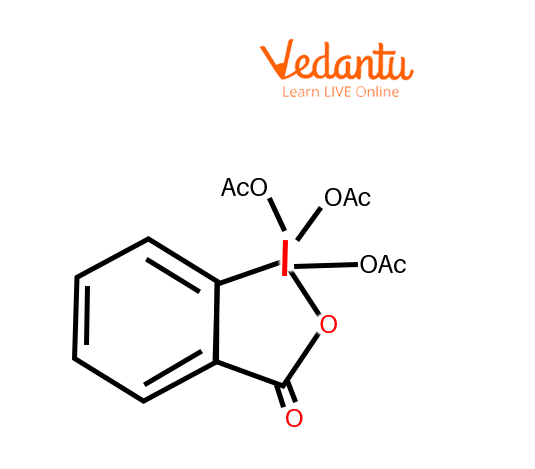
Dess Martin Reagent
DMP could be a relatively mild chemical agent that may be used under neutral conditions providing a high degree of selectivity and functional group compatibility. Other advantages include the fact that DMP is far less harmful than Cr-based alternatives and therefore, the work-up is comparatively easy. One of the main drawbacks is the potential explosive capability of DMP. The cost of DMP is also comparatively high and its high molecular weight typically necessitates using quite a lot of chemical agents.
Dess Martin Periodinane Oxidation
Alcohols can be oxidised to aldehydes, ketones, and carboxylic acids depending on their structure and also the type of oxidant used. Oxidising agents are typically classified as strong and mild oxidising agents. Mild oxidising reagents stop the oxidation of the alcohol once the carbonyl group is formed. And if it's a primary alcohol, the product formed is an aldehyde whereas the oxidation of secondary alcohol leads to ketone formation. The strong oxidising agents oxidise primary alcohols to carboxylic acids and secondary alcohols to ketones.
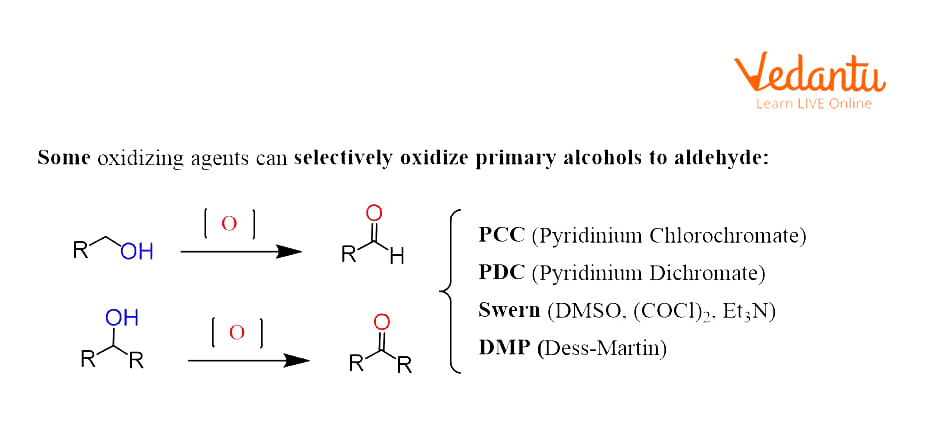
Oxidation of Alcohol Using DMP As an Oxidising Agent
Mechanism of Dess Martin Oxidation
Dess–Martin periodinane (DMP oxidation) may be a selective methodology for oxidising primary alcohols to aldehydes.
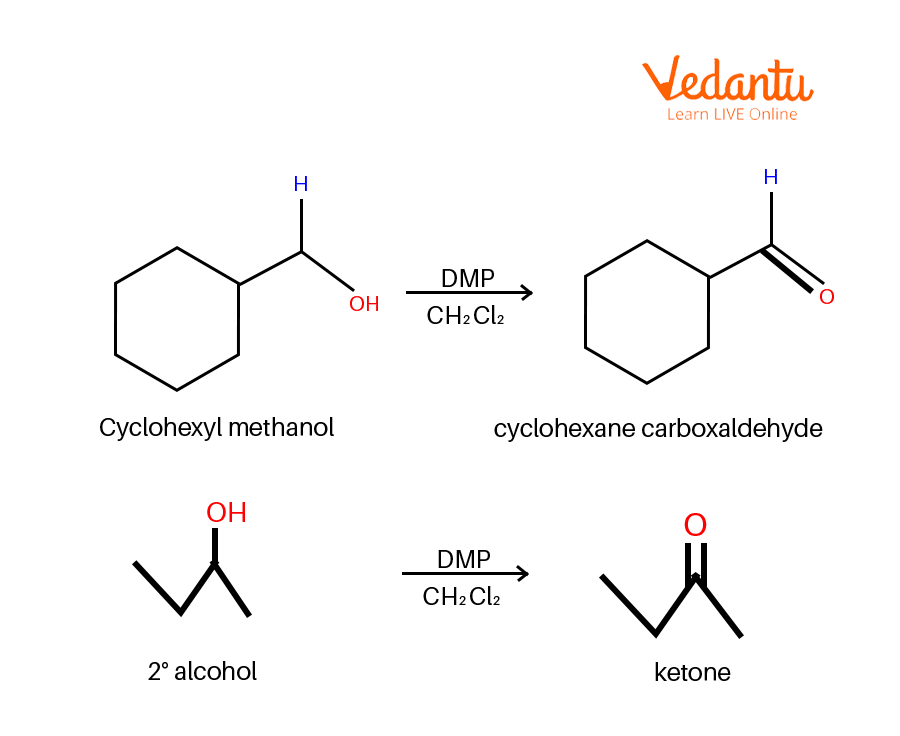
Dess Martin Oxidation Example
Another advantage of using the DMP chemical as an oxidant is that it can be performed under milder conditions and does not need the presence of strong acids. The reaction starts with the substitution of the iodine where the alcohol replaces one of the acetate ions followed by deprotonation that forms an aryl iodo(III) ester–periodinane intermediate.
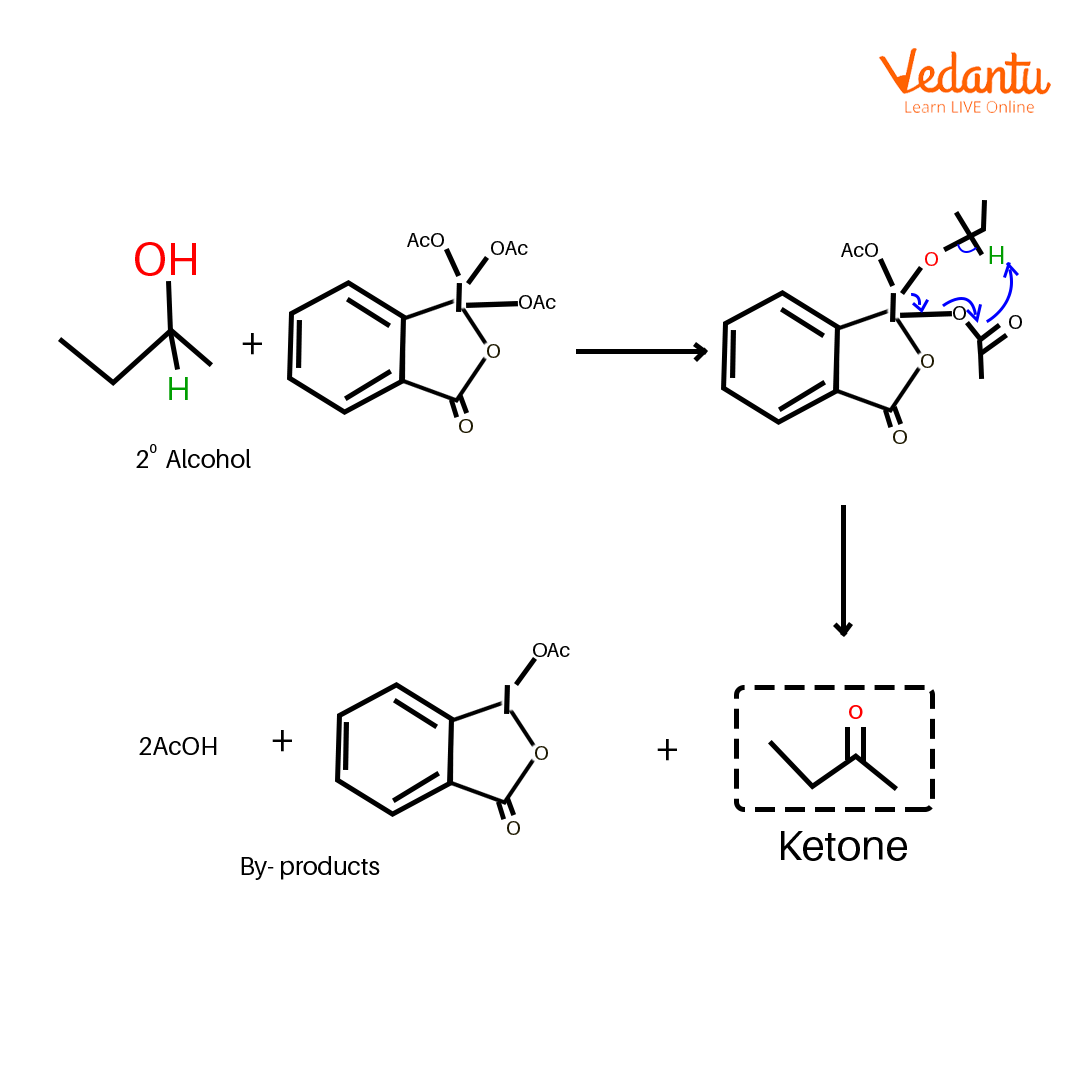
Mechanism of Dess Martin Oxidation
The periodinane intermediate is then transformed to the corresponding carbonyl compound by attainable intramolecular removal of the ɑ-hydrogen to form a C=O π bond.
Preparation of DMP Reagent
Dess-Martin Periodinane (DMP) is an acylated variant of the oxidant IBX. The acyl group provides DMP additional solubility in organic solvents than IBX. The most friendly synthesis of IBX has been determined to be treating 2-iodobenzoic acid with oxone in water, at elevated temperatures for three hours.
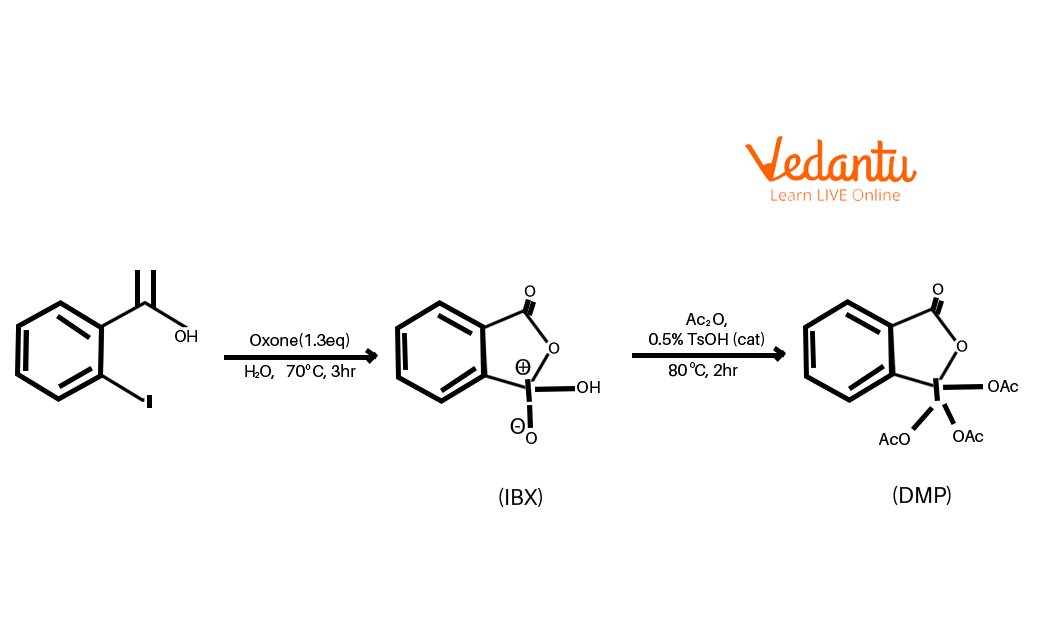
Preparation of DMP Reagent
Interesting Fact
It is named after the American chemists Daniel Benjamin Dess and James Cullen Martin who developed the chemical agent in 1983.
It is based on IBX; however, because of the acetate groups connected to the central iodine atom, DMP is far more reactive than IBX and is much more soluble in organic solvents.
Important Question
1. What does DMP do to primary alcohol?
Ans: DMP is a chemical agent used to oxidise primary alcohols to aldehydes and secondary alcohols to ketones.
2. What is IBX in organic chemistry?
Ans: 2-Iodoxybenzoic acid (IBX) is a chemical compound used in organic synthesis as an oxidising agent. This periodinane is particularly suited to oxidise alcohols to aldehydes.
Conclusion
Dess–Martin periodinane (DMP) may be a hypervalent iodine reagent used to oxidise primary alcohols to aldehydes and secondary alcohols to ketones. This chemical agent is enticing because of its operation under mild conditions (room temperature, neutral pH), short reaction times, higher yields, high chemoselectivity, tolerance of sensitive functional groups, and long life on the shelf. The presence of acetate groups makes DMP more soluble in a very wider range of solvents compared to the IBX chemical agent.
FAQs on DMP Reagent
1. What does DMP chemical do?
DMP chemical agent is a hypervalent iodine compound and it offers selective and extremely mild oxidation of alcohols to aldehydes or ketones. The oxidation is performed in dichloromethane or chloroform at 25°C and is sometimes complete at intervals of 0.5 - 2 hours. The neutral condition of the oxidation reaction makes DMP a suitable alternative in syntheses of sensitive, functionally advanced intermediates. However, use on an industrial scale is made tough by its value and its probably explosive nature. It was developed by the chemists' Daniel Benjamin Dess and James Cullen Martin in 1983.
2. Are reagents and catalysts the same or what is the difference between the catalyst and reagent?
No, reagent and catalyst aren't the same. A catalyst may be a substance that will speed up the rate of a particular reaction, whereas a reagent may be a substance or mixture utilised in qualitative analysis or alternative reactions which may either be a catalyst that accelerates the reaction or a reactant that's consumed throughout the reaction. Examples of reagents include Grignard reagent, Tollens' chemical agent, Fehling's reagent, Collins chemical agent, and Fenton's reagent. Examples of catalysts are potassium permanganate, platinum, palladium, etc.
3. What are the applications of the Grignard reagents?
When haloalkane is treated with Mg within the dry ether as the solvent, it provides alkyl magnesium halide (Grignard reagent). Grignard reagents are used synthetically to make new carbon-carbon bonds. A Grignard chemical agent includes a very polar carbon–magnesium bond during which the atom has a partial negative charge and therefore, the metal has a partial positive charge. Grignard reagents will be used for determining the number of halogen atoms present in a halogen compound. Grignard degradation is used for the qualitative analysis of certain triacylglycerols moreover as many cross-coupling reactions for the formation of many carbon-carbon and carbon-heteroatom bonds.












